This four-image mosaic comprises images taken by Rosetta’s NAVCAM on 7 December from a distance of 19.7 km from the centre of Comet 67P/Churyumov-Gerasimenko.
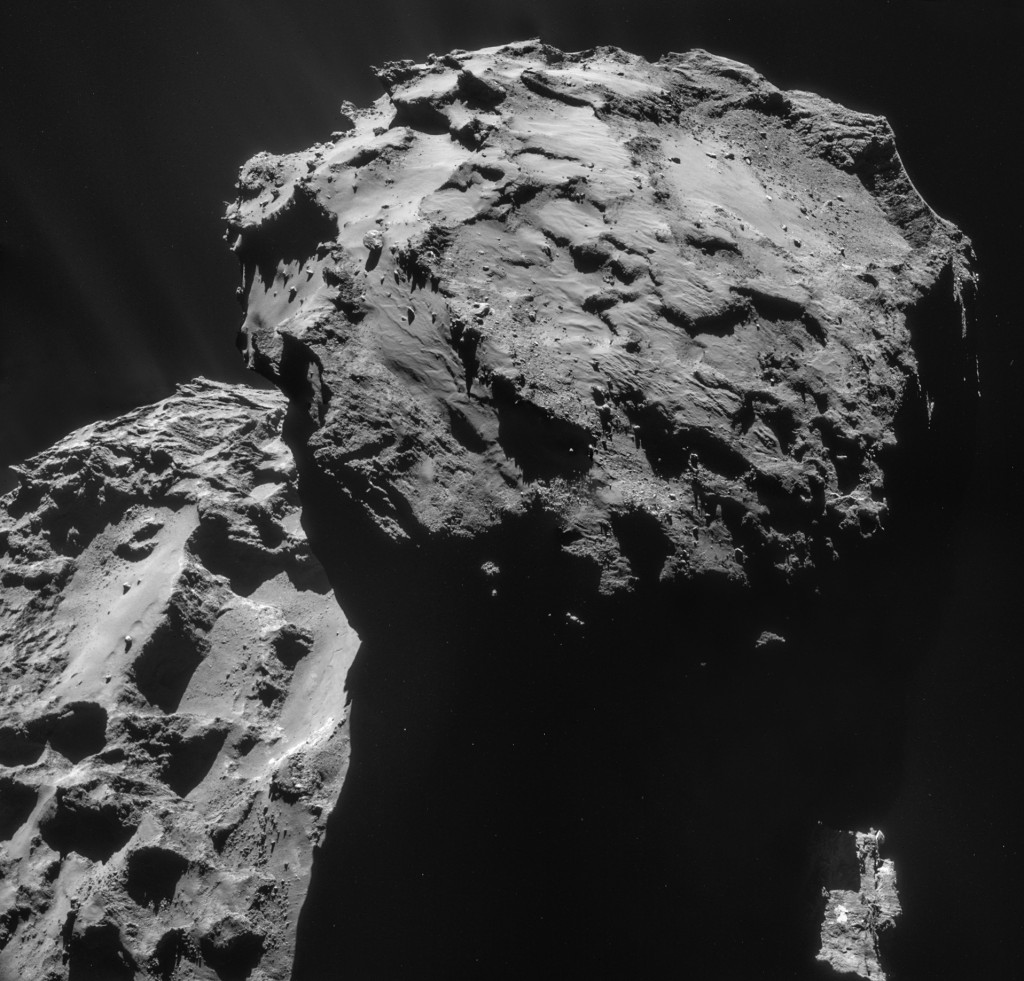
Four image NAVCAM mosaic comprising images taken on 7 December 2014. Credits: ESA/Rosetta/NAVCAM – CC BY-SA IGO 3.0
The image scale is 1.68 m/pixel and each single 1024 x 1024 frame measures 1.7 km across. The mosaic has been cropped and measures 3.2 x 3.1 km, at roughly the same scale per pixel.
As usual, before interpreting the mosaic, do check the original frames (provided below), because the rotation and translation of the comet during the image sequencing makes it difficult to create an accurate mosaic. In this particular instance, some distortion terms were introduced to make the mosaic, albeit still leaving a slight mismatch error at one of the peaks on the top edge of the mosaic.
Internal scattering in NAVCAM also leads to some spurious broad intensity features and thus some cleaning has been applied to lower the impact of the scattering and make the boundaries between images continuous. So, be cautious in pushing the intensities too far to look at very faint features: there will be some artefacts.
The scene shows a great side-on view of the inside rim of the large depression on the smaller of the comet’s lobes (far top right). This viewing angle highlights two different surface textures visible inside the depression – the right hand side (in this orientation) seemingly dominated by rougher terrain and the majority of boulders, while the left hand side is apparently much smoother. Finally, streams of dust and gas can be seen rising from both the large (lower left) and small (upper right) lobes of the comet.
The site at which Philae first touched down is also visible in the top right frame (see here for a labelled image).

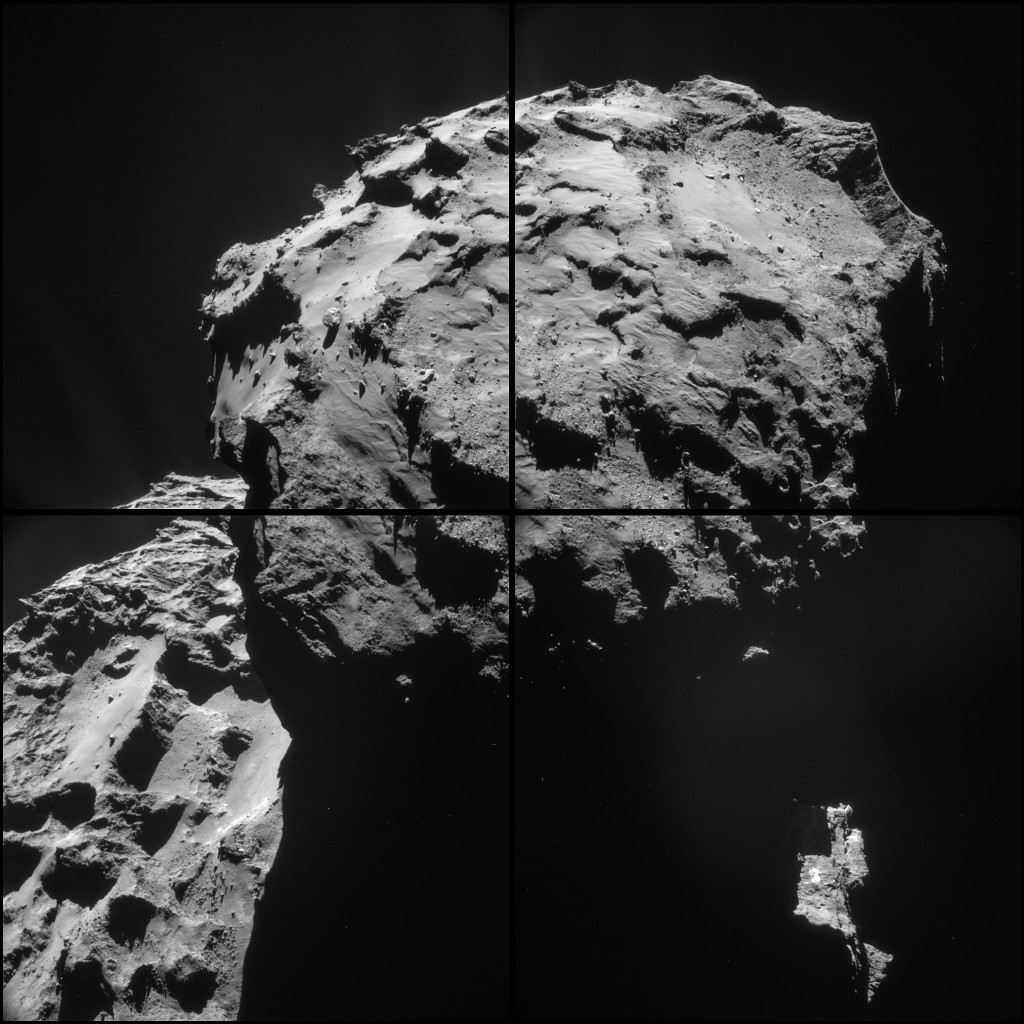
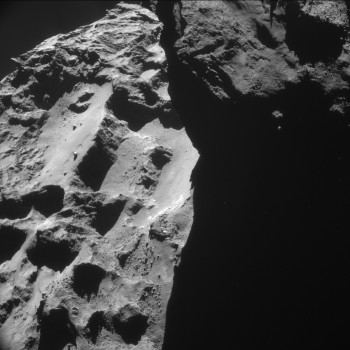
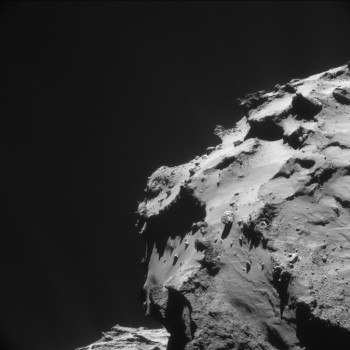
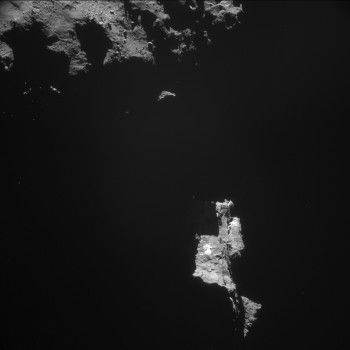
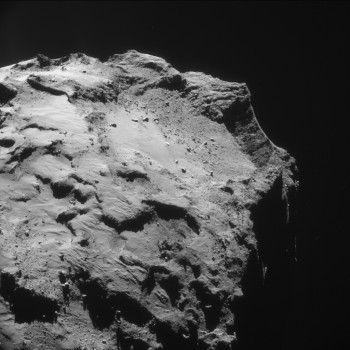








Discussion: 40 comments
This image shows not only “the site at which Philae first touched down” but also, according to an earlier post from 21/11/2014, one of two candidate regions for Philae’s final position. Is there any new conclusion that can be drawn from this image (or an image of higher resolution from the OSIRIS camera)?
this looks like a set of photos of comet Comet 67P/Churyumov-Gerasimenko, am I right? blasé?
ESA should be congratulated for a great job!
Great picture, thanks esa
A real mix of textures, where do you start?
The structure top left that looks like a beached whale from this angle. It looks as though it’s a large flat slab that has fallen over. How?
The right side of it looks like it was once attached, was it once verticle.4
Why is the orbit changed? Why is the recapte getting from bad to worse? Nothing else to do?
Only NAVCAM images have been uploaded these days.
Shoud we expect higher resolution images with OSIRIS coming soon?
Thank you for pictures from unusual angle – I had no idea the rim is so high, it definitely does not look like that from other photos.
I am probably completely wrong but for a few reasons this spot looks like a good candidate for where Philae might be resting.
https://i.imgur.com/Loy7zLA.png
Nice!
There are several bright pixels.
This one has been by favorite, since it’s close to a shadowed area:
https://i.imgur.com/4qp1XpW.png
But I think at this resolution, a before/after comparison, and two “after” images are necessary to consider bright pixels as good candidates for Philae.
Lucky Philae landed in the cliff. The ~smooth surface looks heavily processed: a thin lighter layer, 2 to 3 pixel wide, I guess, covering the rougher cliff…
So lucky ESA, we’ve really landed by chance on one of the rarer spots on the comet… assuming of course Philae is really in the middle of the cliff.
Excellent image Emily. This gives a nice view encompassing all of Philae’s journey across the comet. I have done an annotated diagram like before. The trajectories are not calculated and are an “artist’s impression” of the timeline of events. The incoming flight path and the first bounce direction are based on the OSIRIS images taken before and after the initial touchdown, after that its guesswork based on where I think Philae ended up and the information from the ROMAP team. Philae’s little alcove is circled, but try as I might I can’t make out Philae in this image, just one lighter black pixel that may be her. If OSIRIS captured an image at the same time she may be visible, but the Sun’s angle is not right to illuminate the inside of the little nook. Slightly more of this part of 67P is becoming lit, so there is hope for little Philae still.
https://www.flickr.com/photos/124013840@N06/15985932392/in/photostream/
This may just be the different viewing angle or the Sun angle, but it seems the surface dust/gravel layer is thinner than in the images of a couple of months ago, the bright areas in the neck are more extensive and there is a large bright patch bottom right on the shoulder of the body lobe in a region where there is virtually no surface dust/gravel layer at all. There are now numerous cryoboulders and exposed areas of sub-surface material that look like “ice” as opposed to “rock”. Curtains of dust can be seen rising off the comet, from both exposed subsurface material and areas covered in the surface layer. Things are hotting up.
Hello,
I am just an enthousiast and not a lawyer or anything else so don’t feel frightened 🙂 but :
I saw on your flickr page that you publish your annotated diagrams under a Copyright license (“all right reserved”).
But the license of the work you are using is under Creative Commons SHARE ALIKE license (CC-BY-SA IGO 3.0). This means that you must publish your work under an equivalent license, or the same. That’s what creative commons are made for ! 😀
I hope it’s just a mistake.
Bye your work looks really interesting btw!
Hi RomainBou. To be honest I don’t give a monkey’s who uses my photo stream images. I think the “All Rights Reserved” is the default from when I set up the Flickr account, but I have changed the Rosetta images. Thanks for your interest.
Yay ! Cool thanks a lot for having listened to me! 😀 and answered haha. I think too it’s the default checked box on flickr, and I don’t plan to use your work, but I just wanted to raise awarness on this open licence and the political decision of ESA. The main interesting thing in their decision to publish it under creative commons, is that it shows that they understood how internets work: whatever the licence was, they knew that the images would be shared. a lot. So instead of preventing it, they encouraged it using this licence. And we, the public, the sharers, have at least one thing to do to thank them : using and overusing this creative commons licence! and that’s what you just did.
Hi Robin,
I agree with the general path after the initial bounce. Philae probably then bounced off the crater wall, but in which direction. There is no reason for the lander to continue in the same horizontal path. It could have rebounded completely, or bounced to the left or right and then over the rim. It could have done a complicated tumble (cartwheel) to the left along the inside of the crater wall – say to the upper right of the image – before eventually going over the edge. Remember it kept moving for more than an hour. And there are good reasons for suspecting it didn’t do a high bounce, as that would take considerably more kinetic energy than a “horizontal” tumble.
As I said in my post, after the contact with the crater rim it is pure guesswork. All I had to go on is the COSERT defined search area, which includes the position I have circled and the time of flight. Although there is some foreshortening of the distance into the image, the only way to get a sufficient time of flight for the second bounce is to make it higher. I reasoned that from other bloggers calculations Philae would still have been heading upwards at 46 minutes, together with the cartwheeling motion after this glancing contact, some increase in Philae’s vertical vector was imparted. How much at this point is unknowable. A second slight contact before the second touchdown was mentioned by the ROMAP team. This sort of trajectory could lead to contact with the edge of the cliff just before the valley in the crater rim on the way into the second landing point. I’ve picked my poison and I guess I will have to stick with it, after all its only speculation and a bit of fun.
If you look back at the 28 Nov ppost about “Did Philae graze a crater rim” you will notice thay only showed us another 25 minutes of the spectrograph after the 2nd bounce. I suspect they’ve omitted something as the story gets more complex.
Robin
in a recent Google hangout they gave a little more on the CONCERT defined position for Philae. The explanation (in lay terms) was that when CONSERT was in contact with Philae, it was collecting not only data through the comet, but also when Rosetta was directly above the likely landing area. This gave them effectively a height for the landing position, so the predicted area is like a contour area from a map. The final resting place may yet turn out to be fortunate, providing Philae does come back to life with an increase in solar energy from being closer to our star and the season on 67p changing favourably.
Thanks, it looks like I have spotted nothing in the wrong area!!! It remains an exciting adventure and wait for seeing and knowing more from Rosetta and Philae…meanwhile keep on “searching” : )
https://www.dropbox.com/sh/ow01zijfr7wj09e/AACN8KWJAYZevP_0UdPpkajda?dl=0
Keep up,the great work hope we find Philae at some point
There is a small white dot in image 3 having a shape compatible with the Philae’s one.
The resolution is too low on the publisched image to further investigate and I was wondering if it is worth for you to have a second look (especially if you have better resolution images or other images of that area). I can point to the area, however I do not know how to send an attachment. Regards
These images are wonderful, but what progress is being made towards finding Philae?
And it would be lovely to see some high resolution images (OSIRIS?) around the large depression, especially of Philae’s likely location.
How about posting some B&W Osiris images? You don’t need to keep ALL of them hidden for using in papers to be written who-knows-when. Thanks.
https://www.geek.com/wp-content/uploads/2014/12/67pcorr.jpg It’s not “fifty shades of grey” at all. Its RED!!!!
I’m sure OSIRIS was trying to locate Philae when Rosetta was at around this location in the orbit, or every time she comes to this side of the comet! Looking forward to the news!!
Ah. So beautiful.
So if Philae had anchored at the first landing site it would have been perched on the tip of that image. Probably would not be able to see it but it would have made a glorious labelled picture! Just imagine that.
We hope we find you Philae! THank you for all the data.
What an achievement!
great view of that big drop-off there.
Philae is somethwere there to the right, in that wall or at it’s foot, I would say.
Looking at tht wall, that’s not rock to me. More like some pulpy stuff. Looks also to me as if many of these ‘boulders’ are rounded from rolling.
I really compare this to what happens when flour is spilled, it makes that kind of ‘rocks’ and football to cigar shaped rounded things from rolling. You can make ‘cliffs’ with flour by digging it away that look very similar to that wall there.
Of course, by now it is pretty obvious that ‘looks similar’ may be just looks, and the stuff is something entirely different from expected.
That blackness…. is there a way to find if there is graphene there, flying around in the coma or on the surface?
on the lower left mosaic it looks like there are grooves in the sediment (center of the image)…
i like the images you post on a regular basis – keep it up esa! maybe someone finds philae if you keep posting navcam images 😉 lots of people are searching
thanks to all of you!
Thanks for the splendid images! And I wish I could see the colors!
I had to smile at your modesty in that you actually apologise for a “leaving a slight mismatch error at one of the peaks” in what is a fantastic achievement. For one such as I born in 1947 and growing up with box Brownies, an image such as that from 20 km would be fantastic, let alone having the camera some 500 million miles away. Your achievement beggars belief. Well done to all.
Steve.
Rosettas flight engineers have made such a great job up to now. It’s amazing to see almost daily pictures imaging this strange world of a comet surface. So question: Wouldn’t it be possible to try at the end of the mission something risky: To maneuver Rosetta for an extremely close encounter or even a soft touch down instead of just getting it burned out? Are there plans like this?
There are ideas to end the mission with Rosetta on the surface via a soft landing. It would be right at the end of the mission and the governing factor is the availability (or not) of thruster fuel. Personally I prefer the alternative of a perpetual orbit around the comet, using no thruster fuel and observing the comet again net time it approaches the sun.in 6+ years, and then again and again – till the electronics go phut. If ESA don’t want to put the money in then I’m sure there are enough amateurs who would take the task on.
Emily, you write:
”Finally, streams of dust and gas can be seen rising from both the large (lower left) and small (upper right) lobes of the comet.”
To be precise, I assume you meant rather “Finally, streams of dust and gas can be seen rising *ABOVE* both the large (lower left) and small (upper right) lobes of the comet”.
Actually, the “streams” are clearly emanating not at all from either lobe but, as they have done in every image we have seen since Rosetta has been orbiting the comet, from the “neck” region which is almost completely hidden behind the “head” in this image. Nothing has suddenly changed in the jet-dynamics since the earlier images, presumably (otherwise this would be major news!) It’s just that the lower parts of the jets on the left side of the mosaic are quite simply invisible as they shoot up *in front of* the lighter-toned surfaces of the background “body” lobe and the jets at the top of the image, almost vertical, originate from the hidden part of the neck which is *behind* the foreground “head” lobe.
But please correct me if you have evidence to show that my interpretation is wrong.
Hi Thomas, we have noted in several previous image releases that dust and gas have been seen around/being emitted from both the large and small lobes, in addition to the neck; these two images immediately spring to mind:
https://blogs.esa.int/rosetta/2014/11/26/cometwatch-20-november-in-the-shadow-of-the-coma/
https://blogs.esa.int/rosetta/2014/10/23/comet-activity-is-on-the-increase/
Thanks for your response, Emily.
Perhaps I should have said that the observed jets still seem to be emanating overwhelmingly, but probably not exclusively, from the neck region.
I know the two previous images you refer to very well and thought that in both of them the same predominance of the neck region as the main source of the jets was pretty well established.
There are a few reasons to expect the activity to switch to the lobes closer to perihelion.
1) Hartley demonstrated jets almost exclusively on its lobes.
2) 67 C-P’s change in rotation rate last perihelion points to jets on the extremities as the only realistic way for it to have happened.
3) insolation and tidal forces is increasing on the lobes especially.
working proposal, have m?5 and s?a256 published on big newspapers
hidrocarbons well at pixel 1115,907 of stitched mosaic dec07. Are we seeing the same sources?
reCAPTCHA is broken.
Fifth attempt to post a reply.
–Bill
Great effort by ESA and from the Crowd. I think it is time for Rosetta’s OSIRIS team to put aside their egos and let 10000 eyes look at the hi res images in search for Philae..
Using all of us avid followers would be far far quicker at locating the elusive Philae than the under pressure OSIRIS team whom I am sure are madly writing their peer reviewed papers. Put the image in Tomrod, for example, and take advantage of the free resources that are available would shorten timelines considerably.
If you have already located Philae and are keeping it secret then shame on you.
Watch for a whole series of new data from the AGU meeting in SF this week. Rosetta day seems to be Wednesday (17 Dec) with nearly every instrument team having a session. If they remain so tight lipped as they have so far, I’m not sure they’ll get a rapturous reception from the delegates